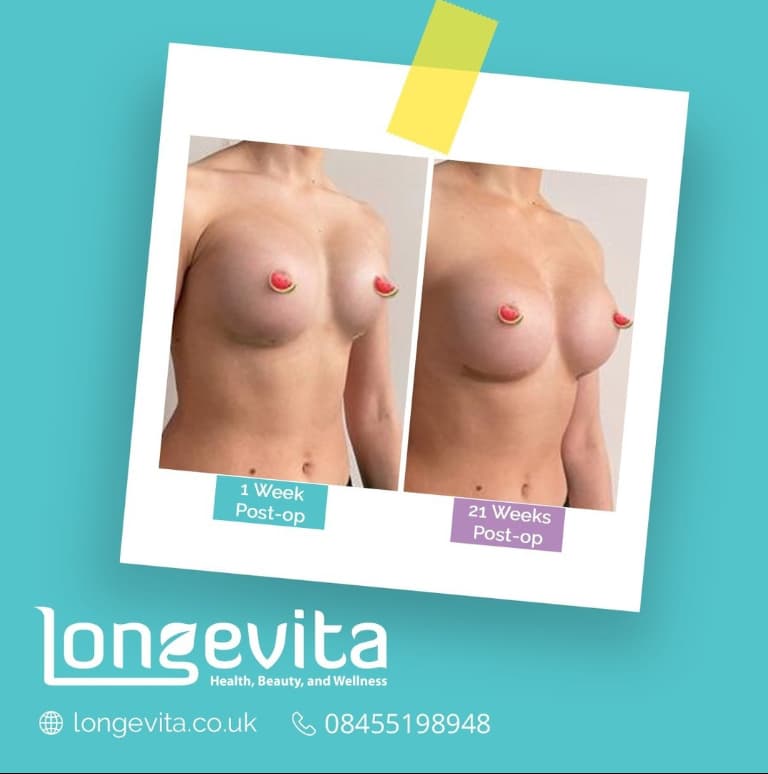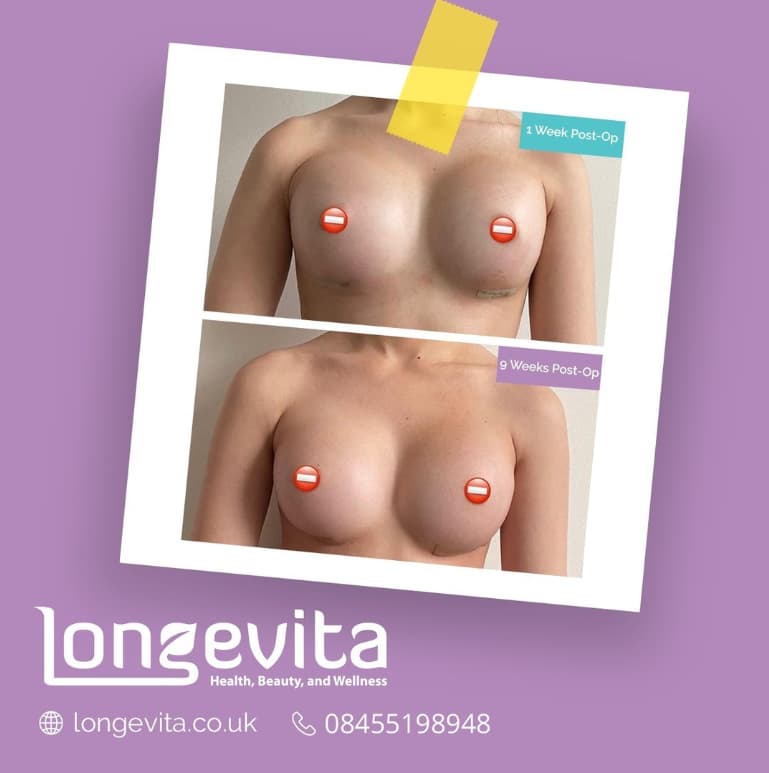As much as you want it, it’s not possible to see the final results of your breast augmentation immediately after the surgery. That’s because, besides swelling, your implants will need some time to “settle” into place. That’s the process of dropping and fluffing. And you won’t be seeing the results of your surgery before this has happened.
Almost all types of implants need to drop and fluff. However, their timelines can vary depending on different factors. Even if two people get the same surgery at the same time, their implants may not settle at the same time. In some cases, the longer it takes for the implants to settle, the more worrying it becomes.
What Is Drop and Fluff?
‘Drop’ refers to the implant ‘dropping’ downward, whereas ‘fluff’ refers to the implant ‘fluffing’ the bottom half of the breast, below the nipple. These processes take place gradually over several months. Keep in mind that they may not occur simultaneously to both breasts, which can make them look temporarily asymmetrical.
Additionally, soon after the surgery, the implants may appear to sit too high on the chest. Your breasts may also look square, flat and even pointy. The reason for this is that your breast tissues (and muscles if the implant is placed beneath it) are constricting the implants.

Your breasts will slowly stretch to accommodate the new implants, after which they’ll finally settle into place. Once that happens, your breasts will look bigger (though they might look smaller for a while after the majority of swelling subsides after 6 weeks).
Moreover, they’ll become softer. The bottom half of the breast will have a greater curvature, and you’ll feel the edge of the implant above the breast crease. Your nipple-areola complex will also rise a little as the breast fluffs up at the bottom.
However, keep in mind that you also need the swelling to subside to see the final results of the surgery. And it can be a year before that happens.
What Is the Drop and Fluff Timeline?
Generally, it takes 3-6 months for the breast implants to drop and fluff. However, these processes can take 6-9 months if the breasts are too small or tubular. Following is a timeline of dropping and fluffing after augmentation surgery:
Post Op: Week 1
Your breasts will feel tight and sore because the tissues and muscles need to stretch to make space for the implants. Moreover, you’ll have swelling, asymmetry, pain, bruising, and numbness at this stage. There may also be nerve pain, which usually feels “sharp.”
Post Op: 6 Weeks
Most of the swelling will subside 6 weeks after surgery. It can make the breasts look smaller, and many patients feel that they should have gone bigger at this stage. However, the dropping and fluffing process is still ongoing. Once the implants settle in the lower half of the breasts, it will make them look bigger.

Post Op: 3-6 Months
At this stage, the bottom of your breasts will become rounder and more noticeable. They will also round out more prominently on the sides. Your breasts will be close to their final shape (unless their size is too small), but you should wait till the 12th month.
How To Speed Up Drop and Fluff?
It’s not possible to speed up the dropping and fluffing of breast implants because it depends on multiple factors that are beyond the patient’s or surgeon’s control.
What you can do is make sure that you follow the aftercare instructions of your surgeon. To help your implants settle in time, do not forget to wear your surgical bra.
Bra bands may also be recommended for some patients to push down the implants. Also known as an implant stabiliser band, it’s worn above the breasts to help with dropping and fluffing. But only use it if advised by your doctor.
Additionally, you may be advised to perform a breast massage for 2-3 minutes for 2 months after the surgery. There are different techniques for it that essentially involve compressing the breasts from the inside and outside. Make sure to consult your doctor about them beforehand. Other than that, make sure to stay hydrated, eat healthy foods, and get adequate sleep.
Things To Consider About Dropping and Fluffing
How quickly your implants settle depends on:
- Skin Laxity – If you have good skin elasticity, it will take some time for the tissues to stretch. However, your implants will drop and fluff more quickly if your breast tissue has stretched due to pregnancy, weight fluctuations, or previous breast surgery.
- Implant Size – Larger implants will drop faster due to gravity. But another thing to consider is that having larger implants will require your tissue to stretch more, which will take time.
- Implant Surface – There are textured and smooth implants. A textured implant’s friction with your breast tissue will slow the drop.
- Natural Breast Size – If your natural breasts are small in size and you have good skin elasticity, the breast tissue will be tightly wrapped around the implant, which will make it go down slower.
- Implant Placement – If the implant is placed over the pectoral muscle, it will drop and fluff more quickly because there would be no pressure from the muscle. There would be no need for the implant to stretch the muscle tissue and the breast tissue.
- Muscle Strength – If the implant is placed under the muscle, its strength will also make a difference. If you’re physically active, you’ll have enhanced muscle strength, which can make it even more difficult to stretch it.
Keeping these factors in mind, just remember that dropping and fluffing can take place at different paces for different people.
What If the Implant Doesn’t Drop and Fluff?
If your implant doesn’t drop and fluff, it could be indicative of capsular contracture. This condition refers to the formation of a ‘capsule’ of scar tissue around the implant. It’s how your body normally reacts to any foreign object.
In the case of implants, this capsule can be problematic if it starts to harden and shrink around the implant. That will prevent the implants from dropping down and fluffing the bottom of the breasts.
This complication can cause both functional and aesthetic problems. If you feel like your breasts are becoming harder, more painful, and too round, you should get in touch with your doctor. Thankfully, this condition is highly treatable.
Implant Dropping vs. Bottoming Out: What’s The Difference?
There’s a clear difference between implant dropping and bottoming out. In both cases, the implant is moving downward, but in the case of bottoming out, the results aren’t aesthetically pleasing.
An implant bottoms out when the skin of the lower half of the breast is overstretched. And this can happen if your breast tissue is too thin or weak. As a result the distance between the nipple and breast crease increases. The bottom half looks too full and almost looks like it’s sagging.
To treat this, usually, an internal mesh is placed below the implant so that it can be supported. Keep in mind that it will not resolve on its own, and you’ll need revision surgery for it.
Dropping and fluffing, on the other hand, is a part of the healing process. And this drop will actually help your breasts look more natural. So, it’s nothing to worry about. It will resolve on its own.
Conclusion
Even the slightest changes in the breasts can give you a scare during recovery. But rest assured, dropping and fluffing is nothing to worry about. It is normal and part of the recovery process.
Keep in mind that in order to place the implant, plastic surgeons create a pocket in the breasts. Until your implants settle into that pocket, you will not see the final results of the surgery. Usually, this settling process takes 3-6 months (you can take pictures of your breasts to see how they change over time), but if you feel that you’re not recovering normally, get in touch with your doctor.
Reviewed and approved by Prof Dr Fuat Yuksel.




